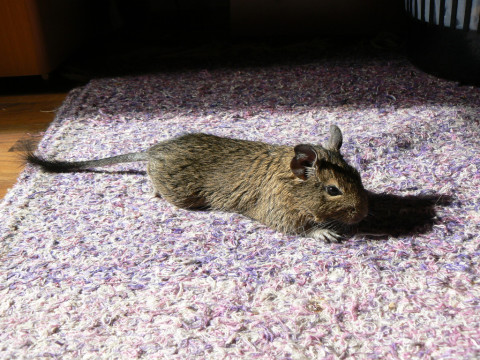Degu is such a cute little animal. Not a mouse nor a rat, but a separate independent species of rodents related to the chinchilla, capybara and guinea pig. Degu reminds me of a platypus, which is like a mixture of different species. Degus have the muzzle of a capybara, the tail of a gerbil, and the habits of a chinchilla or squirrel. A degu can be recognized by the brush at the tip of the tail, the light fur around the eyes, the gray color of the skin, the fur over the paws and even the fingers, and what appear to be human-shaped ears.
Degus can be kept at home as pets. They live much longer than mice and rats, and smell much less. However, these animals are still a little wild by nature and sometimes bite painfully. In this free story, I will share my experience in taming this wild entity.
As with the training of any other animals, the principle of carrot and stick works with degu. However, they are incredibly stubborn creatures. It often takes a lot of patience and time. Getting close to degus can take anywhere from a few months to a year of painstaking grooming. All the techniques that I will describe below, I came up with myself. Just because it worked for me doesn't mean it will work for you.
In the wild, degus had to learn to be very cautious and shy in order to be less likely to get caught by predators. Any unknown rustle or movement can easily scare them away, so you need to establish a trusting relationship step by step and slowly. It is also worth noting that during the day their mood and interest in things change: that is, at some moments they are more prone to contact, and at some they want solitude. Be observant of the behavior of degus and notice their state of mind.
Video: valkatr_-_degu_charming.mp4 (194 MB).
Try not to push to the degu aggressively. Approach your hand and patiently wait for him to become interested in it. Let him sniff his fingers and get used to them in the absence of stress. Then you can try gently caressing the degu with your finger. Degus, like cats, have places on their body that they prefer to touch and places that cause them stress. If you have several degus, then you can pay attention to the moments when they groom each other. Your task is to simulate this interaction. Usually they take turns gently biting each other in the neck. Methodically grope with your finger for a place where strokes are pleasant for them. Avoid moving and touching areas that cause them stress. In the end, if you manage to do everything right, you will be able to feel the area somewhere on the chest near the shoulder, and smooth strokes with your finger will cause pleasant sensations in the animal, from which it will move its front paw to the side, back, as if exposing the area that you need keep stroking. Consider it a small win, but remember observations of their behavior: they take turns doing it. Therefore, after caressing the degu in this way, let him in return, as a thank you for the pleasant sensations, bite your fingers a little. The stronger this biting, the more he liked it. If those reciprocal nibbles are too painful, then move your hand back a little and let him try again if he wants to. He will quickly figure out what your limit is. Repeat this simple ritual as often as possible and soon you will become strong friends.
In addition to the chest area, degus also have places that can cause pleasant sensations. For example, behind the ear or fluff inside the ear. A sign that you are caressing the degu's ear correctly is a twitch of the ear itself and a slight turn of the head to the side. The ear can also be rubbed with your fingers, thereby cleaning off dead skin. This causes conflicting sensations in the degu, on the one hand it hurts, and on the other hand it is so pleasant and unusual that he may even start to chirp and squeak. Here, carefully seek a balance with the force of grinding, so as not to overexcite the degu. Note that the ears do not always have dead skin. When there is nothing to clean off, then grinding no longer causes such strong emotions in them. I believe that the sensations they experience while doing this are probably similar to the ASMR effect in humans (this is a slight euphoria that can sometimes occur for some, for example, when combing hair or touching certain parts of the body with a feather, especially if someone else does this).
Another place that can cause interesting sensations in degus is the lips on the side near the incisors. Proper stroking of this place makes them seem to grin, smirk. And stroking the bridge of the nose is interesting to them, but you should not start too close to the nose. And it won't let you do it right away. A good sign: lowered ears and a slight tilt of the head.
Proper feeding can also help bond. The following is a list of foods in order from the most boring to the most interesting and desirable:
- hay
- bark of fruit trees (apples, pears, plums)
- degu food (some brands of food may taste better than others)
- treats for rodents
- hazelnuts, dried bananas (required without sugar!)
There should always be hay and degu food in the degu cage. But tasty treats should be added only after some time after they have already eaten all the previous ones. Nuts should be given in training sessions. The idea is to play with contrasts. If they always have the most delicious food, then there will be nothing to attract their attention. It is necessary that they have an association: the owner appears - it means that now it will be tasty and pleasant.
With nuts it is convenient to lure the degu to the right place, and in general to play with it with the help of them. When offering a nut, you need to pronounce the name of your little furry friend, or even just do "ks-ks-ks." After doing this for some time, then you can call him by name or ks-ks, and he will run up to you in anticipation of a nut. This can be convenient if the degu has climbed into a hard-to-reach place and needs to be pulled back somehow without stressing the animal. Also, if the degu is shy, but he still follows the nut, then you can place the palm of your other hand in front of him and thereby, as it were, persuade him to step on it on his own. If a degu is afraid to crawl out of an open cage on his own, then a tasty nut in front of the entrance can give him courage. It doesn’t have to be a nut, any highly desired yummy will do: pumpkin seeds or sunflower seeds, dried fruits. Try and see what interests him the most.
Somehow it became necessary to wash the degu, and no matter how carefully and gently I tried, he did not like the water at all. From which I had the idea that wetting it with water can be used as a punishment in which case. As long as it is wet, it sits still quietly and recovers. Before punishment, it is worth shouting something like "fu!". After several water procedures, this "fu!" you can stop his pranks, if that is required.
Although degus look almost the same and are difficult to distinguish from each other, nevertheless they can be very different from each other in temperament, character and behavior. I guess everyone needs an individual approach, so some of the above may not work and finding a common language can be a difficult task. The general principle is quite simple, methodically look for a way to make the little one feel nice, then establish the conditions under which he deserves this pleasure. A degu cannot love his master as a rat does, he rather tolerates him.
Love your degus with all your heart and you will be fine together!


Comments